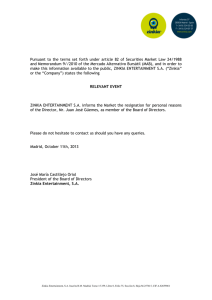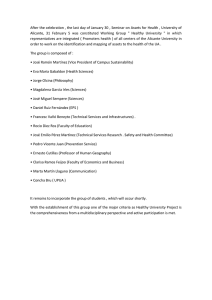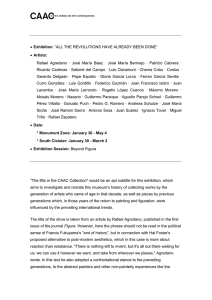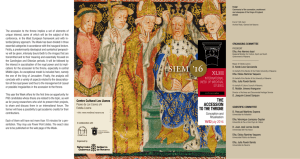Women. Types and stereotypes. Ortiz Echagüe
Anuncio
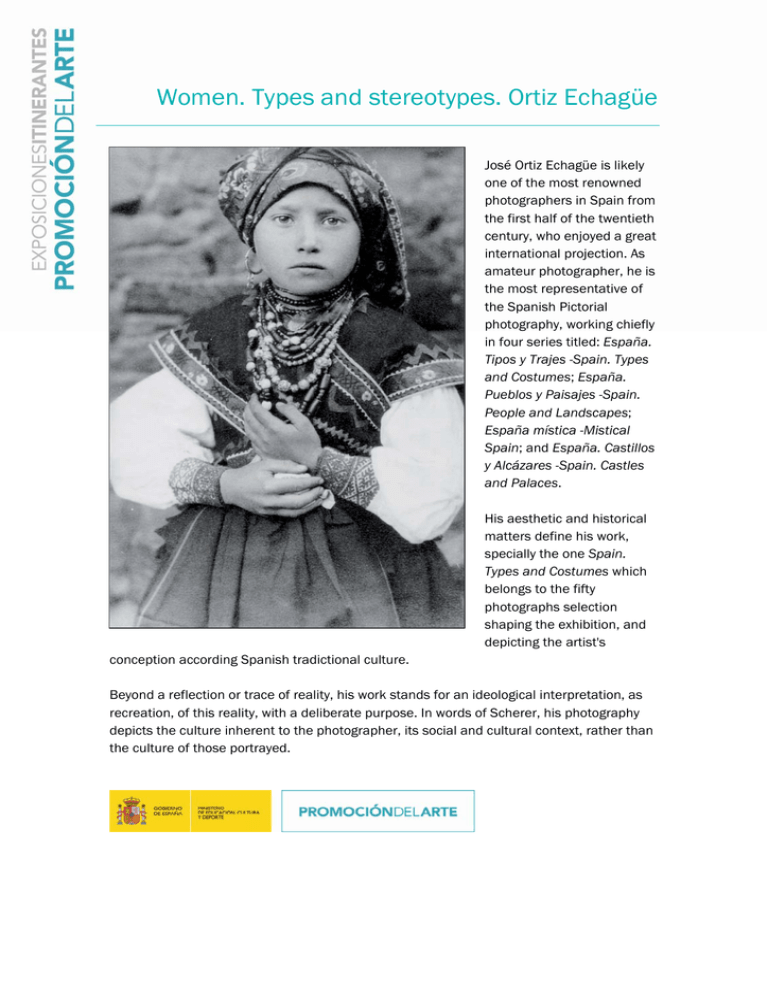
Women. Types and stereotypes. Ortiz Echagüe José Ortiz Echagüe is likely one of the most renowned photographers in Spain from the first half of the twentieth century, who enjoyed a great international projection. As amateur photographer, he is the most representative of the Spanish Pictorial photography, working chiefly in four series titled: España. Tipos y Trajes -Spain. Types and Costumes; España. Pueblos y Paisajes -Spain. People and Landscapes; España mística -Mistical Spain; and España. Castillos y Alcázares -Spain. Castles and Palaces. His aesthetic and historical matters define his work, specially the one Spain. Types and Costumes which belongs to the fifty photographs selection shaping the exhibition, and depicting the artist's conception according Spanish tradictional culture. Beyond a reflection or trace of reality, his work stands for an ideological interpretation, as recreation, of this reality, with a deliberate purpose. In words of Scherer, his photography depicts the culture inherent to the photographer, its social and cultural context, rather than the culture of those portrayed. Women. Types and stereotypes. José Ortiz Echagüe José Ortiz Echagüe -Guadalajara, 1886 – Madrid, 1980-, became one of the most renowned photographers in Spain from the first half of the twentieth century. Amateur photographer and professional engineer, managing both aeronautic and automovilistic entreprises -C.A.S.A. and SEAT respectively-, he started his photographic career in 1906, during the Spanish Regenerationism, which sought for the solution to the identity decline, for the ethical and social values stability restoration of the Spanish society. Within this context will be colaborating outstanding artists like Sorolla, Zuloaga and his brother Antonio, together with Ortiz Echagüe, strongly committed. He stood out in the Late Pictorialism. His four series with classical themes, Spain. Types and Costumes; Spain. People and Landscapes; Mistical Spain; Castle and Palaces, were indeed self-published several times by the author. These series are created within a defined production criteria, placing the coal directly to Fresson paper, which turned each copy into an original work, rather than a mere reproduction out of the negative image, as we can recognize from the different versions of the images published in the several editions of his work. In order to bring out the beauty of his photographs, Ortiz Echagüe worked on different tecniques: he emphasised the main figure's outline over a smudgy black ink pad background, he scraped to erase the flaws, and especially he used the pencil for retouching, focusing on the enhanced beauty of the woman's face, so as to recreate an ideal image. Devout for Calendar © José Ortiz Echagüe. Photographic Collection of the Universidad de Navarra. Fundación Universitaria de Navarra. VEGAP, Madrid, 2012 The Museo del Traje. CIPE -Garment Museum-, comprises a wide collection of 217 copies from the series Types and Costumes, most of them are signed and titled at the bottom of the photograph by the author, some of them are unedited, which were acquired in 1933 intended for the Museo del Traje Regional e Histórico as a documental and exhibition aim reinforcement along the collections of the regional costumes, which reveals an additional stage of Ortiz Echagüe's work: his interest for documenting essences in the process of vanishing, for freezing types and, so, stereotypes, chiefly depicted in his women portraits. Hence, both aesthetic and historical aspects articulate his work, particularly in the series Spain. Types and Costumes, which takes part in this exhibition. According to numerous researchs, the photographer brought together art and documenting, reinforcing the 2 ethnographical base of his work. When going through his work production, his personal perspective construction reveals clear, whilst decreasing the objectivity of documentary; this way, the construction of a decontextualised reality turns into an artistic creation. Therefore, the work of Ortiz Echagüe, beyond a reflection or trace of reality, it stands for an ideological interpretation, as recreation, of this reality, with a deliberate purpose. In words of Scherer, his photography depicts the culture inherent to the photographer, its social and cultural context, rather than the culture of those portrayed. 3 Women. Types and stereotypes. José Ortiz Echagüe Images Water and bread, 1927 © José Ortiz Echagüe. Photographic Collection of the Universidad de Navarra. Fundación Universitaria de Navarra. VEGAP, Madrid, 2012 4 Charra or Girl from Alberca, 1930 © José Ortiz Echagüe. Photographic Collection of the Universidad de Navarra. Fundación Universitaria de Navarra. VEGAP, Madrid, 2012 5 Montehermoseñas -Girls from Montehermoso-, Cáceres. 1931 © José Ortiz Echagüe. Photographic Collection of the Universidad de Navarra. Fundación Universitaria de Navarra. VEGAP, Madrid, 2012 6 Chula del mantón -Chula with a shawl © José Ortiz Echagüe. Photographic Collection of the Universidad de Navarra. Fundación Universitaria de Navarra. VEGAP, Madrid, 2012 7 © José Ortiz Echagüe. Photographic Collection of the Universidad de Navarra. Fundación Universitaria de Navarra. VEGAP, Madrid, 2012 8 © José Ortiz Echagüe. Photographic Collection of the Universidad de Navarra. Fundación Universitaria de Navarra. VEGAP, Madrid, 2012 9 © José Ortiz Echagüe. Photographic Collection of the Universidad de Navarra. Fundación Universitaria de Navarra. VEGAP, Madrid, 2012 10 Women. Types and stereotypes. José Ortiz Echagüe Catalogue Edition © SECRETARÍA GENERAL TÉCNICA Subdirección General de Publicaciones, Información y Documentación. Ministerio de Cultura Servicio de Publicaciones y Venta. C/ Abdón Terradas, 7. Madrid. Telephone: +34 91 544 81 05 Year of publication: 2002 NIPO: 176-02-044-8 ISBN: 84-369-3576-4 11 Women. Types and stereotypes. José Ortiz Echagüe More information Women. Types and stereotypes. José Ortiz Echagüe http://www.mcu.es/promoArte/CE/Exposiciones/MujeresTiposEstereotipos.html http://www.mcu.es/promoArte/CE/Exposiciones/Expo_ExpoItinerantes.html Contact details PROMOCIÓN DEL ARTE Ministerio de Educación, Cultura y Deporte http://www.mcu.es/promoArte/index.html promocionArte@mecd.es http://www.facebook.com/PromocionDelArte http://twitter.com/#!/PromociondeArte http://pinterest.com/promociondearte/ #PromociondelArte 12 CONDITIONS REPORT FOR TRAVELLING EXHIBITIONS EXHIBITION TITLE WOMEN. TYPES AND STEREOTYPES. JOSÉ ORTIZ ECHAGÜE EXHIBITION PRODUCTION Ministerio de Educación, Cultura y Deporte. Secretaría de Estado de Cultura. Dirección General de Bellas Artes y Bienes Culturales y de Archivos y Bibliotecas. Subdirección General de Promoción de las Bellas Artes TECHNICAL DATA OF THE EXHIBITION Total number of works: − 80 framed works. Same sizes: 80 x 90 cm. INSTALLATION: − − Showroom space: 250 linear metres. Preventive conservation and suitable lighting levels for photography -including a time-limiting light control- are required. SHIPMENT OF THE EXHIBITION: − − Packing system: 8 wooden crates, containing 10 works each one. Sizes and content details are provided in the Packing List. Only companies specialized in art shipment, qualified in preserving and installing artworks, are selected. CONDITIONS OF PARTICIPATION EXPENSES COVERED BY THE MINISTERIO DE EDUCACIÓN, CULTURA Y DEPORTE. − − − − Production. Coordination. Insurance. Packing. EXPENSES COVERED BY THE INSTITUTION HOLDING THE EXHIBITION: Installation and Transportation services: − Travel, accommodation, and daily allowance throughout the installation period and official opening. − Fees intended for the manager in charge of the installation. − Round-trip shipping. − Installation and lighting of the showrooms. − Vinyl graphic production. − Surveillance and security officers service. − Unpack, installation, dismantling and repack. SEVERAL CONDITIONS WHEN HANDLING AND PACKING THE ARTWORKS: The works are framed in steel grey wooden frames, this requires extreme care when manipulating to avoid scratching. Use of gloves when manipulating. Qualified staff and protecting tools should be provided during the unpacking, install and repacking; follow the precise Packing List order details when repacking; use of suitable material for packing and an impact and vibration vibro-isolatuing system in the crates; security surveillance of works shall be ensured from the time of delivery, set up, dismantling, and return. Catalogue of the exhibition: - In order to get a copy please contact with the Secretaría General Técnica, Subdirección General de Publicaciones, Informatión y Documentación of the Ministry of Education, Culture and Sport of Spain, in charge of the edition of the catalogue: Tomy Lorenzo C/ Abdón Terradas, nº 7 28015 Madrid Tel. +34 91 543. 93. 66 Fax: +34 91 549. 34. 18 email: tomy.lorenzo@mecd.es Catalogue price: 40 euros (VAT included). NOTE: Once an exhibition application has been accepted, a subsequent collaboration Agreement will be signed between the Ministerio de Educación, Cultura y Deporte and the institution where the exhibition will be held.
